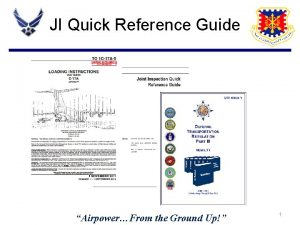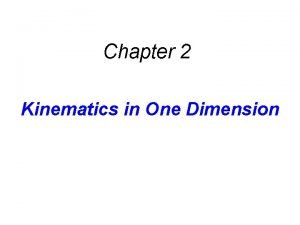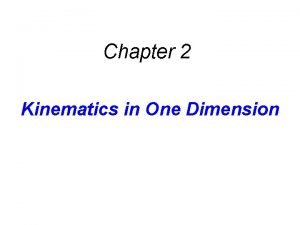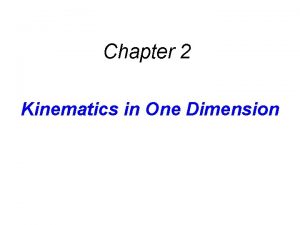QUICK GUIDE KINEMATICS KINEMATICS Kinematics deals with the








- Slides: 8

QUICK GUIDE KINEMATICS

KINEMATICS • Kinematics deals with the descriptions of motion. • Key vocabulary words in this unit include: distance, displacement, speed, velocity, and acceleration.

KINEMATICS • Distance vs Displacement • Distance is a scalar meaning that direction or path does not matter. • Displacement is a vector meaning that direction matters, and the change in displacement depends only on the starting and ending positions • Example: A person walks 10 m to the right, then 6 meters back left. • Distance travelled would be 16 m • Displacement of the person is only 4 m

KINEMATICS • Example 2: A person walks 4 m east and then 3 m north. • Distance travelled is 7 m • The displacement is a little more complex since the person changed directions. You must complete a right triangle to add the displacement vectors. The hypotenuse of this triangle will demonstrate the change in the person’s position which is 5 m.

KINEMATICS • Speed vs Velocity • Speed is a scalar that tracks the distance travelled over time. • Velocity is a vector that looks at the change in position over time. Positive and negative values represent the direction of velocity. • Speed is magnitude (amount) only, while velocity includes both magnitude and direction.

KINEMATICS • Acceleration • The change in velocity over time • Objects accelerate when the speed up, slow down, or change directions • Positive and negative signs matter in terms of correctly analyzing the motion of an object. • An object may speed up with a negative acceleration

KINEMATICS • Speeding up vs Slowing down • If the object’s velocity and acceleration are in the same direction, the object will see an increase in velocity. • If the object’s velocity and acceleration are in opposing directions, the object will see a decrease in velocity. • Ex: A car moves to the left with a velocity of 15 m/s and has an acceleration of -2. 5 m/s 2. • Since the car is moving left it has a negative velocity (direction). The direction of velocity matches the acceleration so the car has an increasing negative velocity in the above example. Speeding up in the negative direction.

KINEMATICS • What if an object moves in two-dimensions? • The horizontal and vertical motions of an object are independent of one another. The only variable they have in common is the time interval. • The horizontal velocity (vx) of a projectile is constant, unless an outside horizontal force is given in the question. • The vertical velocity (vy) of a projectile is constantly changing because the force of gravity acts in the vertical direction.















